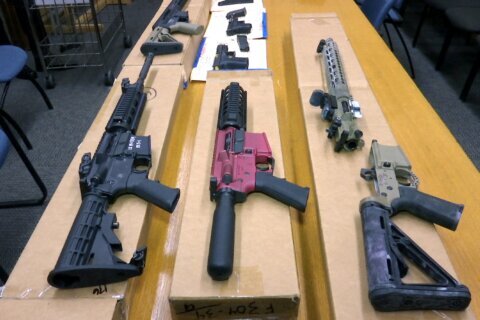WASHINGTON — Although police body cameras have been grabbing headlines since the police shooting of an unarmed teen unleased days of riots in Ferguson, Missouri, last year, dashboard cameras have been used by police departments for years as a way to hold both officers and citizens accountable.
And in one Maryland county a broken in-car camera is providing proof of just how powerful these tools can be. A recent audit found hundreds of dashboard cameras in Prince George’s County are broken. The audit results come several months after an off-duty police officer was killed while trying to conducting a traffic stop – the camera inside his cruiser wasn’t working and didn’t capture the officers’ final actions.
Officer Brennan Rabain was killed when he veered off the road and struck a fence. His blood alcohol content was measured at .07. He was driving an older model 2006 police vehicle, which was equipped with a dash-mounted video camera but it was not functioning at the time of the crash.
The circumstances surrounding his death are still unclear, partly because the dashboard camera could not offer any clues about whether any other vehicles were on the road at the time or what car he was trying to stop.
According to an internal audit, about 30 percent of Prince George’s County Police Department dashboard cameras in active patrol cars are not working. Three-hundred seventeen of those in-car cameras, out of 1,048 total, have hardware or software issues including recording problems, audio issues, playback errors, or they simply do not turn on, WTOP learned from information requested through the Maryland Public Information Act.
Starting in 2000, the department began installing dashboard cameras in its police cruisers using a VHS-based system. In 2004, the department moved to a DVD-based system, which is manufactured by Kustom Signals Inc.
“A year or two years ago, Kustom stopped making parts for these specific cameras. The technology world, and specifically in-car cameras, has moved on and no one makes DVD-based systems anymore. Everyone’s moved to hard drive-based systems. And in fact, we’ve moved to hard drive-based systems too,” says Captain Bill Alexander with the Internal Affairs Division.
About half of the cameras currently in police cruisers are DVD-based Kustom cameras (556) and more than half of those (278) are registered as broken or nonfunctioning.
The department is starting to phase out DVD-based Kustom cameras in favor of Panasonic cameras that store the footage on internal, computer hard drives. Today, 492 police vehicles have the newer Panasonic dashboard cameras. During the course of the audit, 39 Panasonic cameras were reported to have relatively minor hardware or software issues.
The maintenance contracts with Kustom stated technicians will attempt to fix a broken camera but some parts simply aren’t produced anymore.
“We had this contract looming and we had to decide, is it worth putting money into extending a contract where we probably would not get a lot of benefits,” Alexander says.
The latest maintenance contract with Kustom, worth hundreds of thousands of dollars, ended in May 2015. “To extend that maintenance contract probably would be putting good money after bad,” he says.
Dashboard cameras are not required for county officers but Alexander says “we think it’s an important part to be transparent to our community. We think cameras overall are a good thing.”
For almost a decade, every new Prince George’s County Police cruiser came with a new dashboard camera. But the Kustom cameras’ typical life span is three to five years. Alexander says the department was using the cruisers for longer than that, so deterioration and technology changes were inevitable.
“We’re not saying the cameras are bad, we’ve been using the cameras far longer than the typical life span of the camera and in combination with the fact that the technology world has moved on, they don’t make parts, it’s not even possible for us to repair them at this point,” he says.
Moving forward, the department is anticipating transitioning some cruisers with broken cameras to a non-patrol capacity, for example, to training units which are not responsible for emergency calls or traffic stops. The department also approved the introduction of 100 new marked cruisers by the end of the year. Some cars with broken dashboard cameras were due to be phased out anyway due to high mileage or age.
By the end of the year, police officials expect about 150 cars will still have broken dashboard cameras and some newer cars will be fitted with new $5,500 Panasonic cameras.
“We’re not interested in investing that kind of money into a car that is going to be phased out over the next year or so. It doesn’t make financial sense to put that kind of money into the car that might be gone sooner rather than later,” Alexander says.
Kustom will provide a technician for up to one year to strip some broken cameras out and use those parts to fix other broken units.
By the end of the year, Alexander says he doesn’t think 100 percent of the cameras will be at full capacity. “But we will close the gap …. This is not an effort to reduce the number of cameras we have. It’s really us trying to be fiscally responsible. Find a way to maintain equipment that is operating well outside its normal life span.”
Prince George’s County Police Department has more dashboard cameras than the other local police departments that responded to WTOP’s request for the dash cam figures. Of those, Prince George’s County has the highest percentage of malfunctioning cameras.
The Montgomery County Police Department has 562 in-car cameras, of which only two were sent back to the factory for repair last year. Dashboard cameras automatically record when the vehicle’s emergency lights are activated. Cameras are required to record during traffic stops, vehicle pursuits, emergency responses, prisoner transports and crimes in progress. Montgomery County police officers are also required to test their cameras before their shift and report any issues to their supervisor.
The Fairfax County Police Department has at least 620 in-car cameras. Currently about eight are out-of-service, most with software issues, but video capabilities are still intact in those cases.
The Metropolitan Police Department does not have an in-car camera program.







